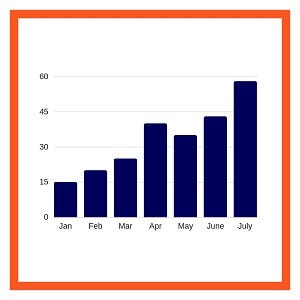On 1 June 2018, I became the Head of Communications for Hostwriter, a Berlin-based nonprofit that is an open network helping journalists to easily collaborate across borders. My background is in marketing and mass communications, and I had served as the Head of Outreach for a nonprofit for several years, so I immediately got to work assessing what resources were already at my disposal and which I would need to create myself.
By resources, I’m talking about spreadsheets.
I’m not the most expert spreadsheet creator, but I do accept the necessity of having a simple, organized way of keeping track of a lot of information. Hostwriter had not had a Head of Marketing & Outreach before, and the Head of Communication had joined the organization just eight months prior to my arrival, taking over some duties from a very busy CEO — Tabea Grzeszyk — who had been devoting what felt like 90+ hours per week to the organization that she had co-founded.
When you are running an organization with a small, busy staff of a handful of part-timers, you don’t always have time to sit down and get organized, no matter how much you would like to. But taking the time to create spreadsheets that will help you in tracking important details is well worth it in the time you will save down the road.
Therefore, I’d like to share the five most important spreadsheets I focused on in my first two months in my new position.
1. Key Performance Indicators — As a nonprofit, Hostwriter needs to regularly report to funders on our progress toward certain goals. Because we are a membership organization, one of our goals is to increase the number of our members. We have other goals, as well, for our outreach on social media. To make it easier for us to keep track of our progress toward our various goals, the first spreadsheet I worked on was one for tracking our progress on Key Performance Indicators (KPIs).

While records of certain KPIs already existed in some form based on past reports to funders, Tabea Grzeszyk — our CEO — and I brainstormed additional KPIs we wanted to track. I created a new spreadsheet to pull in information that was already collected in other formats, and I added the newly-discussed KPIs to the spreadsheet. I created some basic line charts so that we could see a simple, at-a-glance representation of what the monthly numbers meant — were our website visitor numbers increasing or decreasing, were we consistently posting on social media each month, and were we steadily growing our membership?
Each month, after updating the spreadsheet with new data, I meet with the staff to talk about the numbers, how we can improve our progress toward goals we may not have reached, and steps we can take in the next month.
2. Press Contact List — In the first week that I started working for Hostwriter, our organization won the Jury Prize from the Google Impact Challenge in Germany and received €500,000. Big news! After we wrote the press release about it and posted it on our website and shared it on social media, my next thought was, “Which reporters should we send this to?” I think many folks consider social media promotion to be enough, but a part of me is still very “old school” about outreach, and so I like to send press releases to select relevant reporters via email to open a 1:1 dialogue with them.
Other staff members had recommendations for me, so I put together a spreadsheet for my own use with info on magazines, newspapers and digital newsletters that would be most relevant for receiving news about a nonprofit journalism startup. This list was also useful to me and saved me time when — just two months later — I had to announce that we were accepting applications for the 2018 Hostwriter Prize, which would award €5000 to collaborative journalism stories and pitches.
3. List of Past Press Coverage — Sometimes, in order to figure out where you’re going, it’s helpful to know where you’ve been. This is also true as far as press coverage of your organization goes. What outlets have been open to writing about your nonprofit in the past? Which reporters is your CEO already on good terms with? Nothing is more embarrassing than pitching a story to a reporter who just wrote about your organization three weeks ago! Well, maybe some things would be more embarrassing, but I’d rather not think about those.
Hostwriter’s website already had a good listing of stories written about it in the past, as well as some blog posts announcing other news stories, and I didn’t want to let any media mentions slip through the cracks, so I created a spreadsheet to keep everything in one place that could be easily scanned for dates, publications and reporter names.
4. List of Conferences We Participated In — Being a platform for international journalism, it goes without saying that our staff travels quite a bit to conferences for journalists. As I scanned Hostwriter’s blog history, I saw that, early on, there were many posts about the conferences where a member of the Hostwriter staff was a presenter, panelist or moderator. However, as the organization grew and staff traveled more, there wasn’t as much time for them to also write blog posts about every presentation and workshop.

I read through the past blog posts, social media posts and recent reports to funders to gather together information about all of the important events where Hostwriter, or a member of the staff, was involved. Having all this information in one place would make it much easier the next time a report was due to funders, or when we were deciding which events to apply to speak at in the future.
5. Global Events Calendar — As an organization that is focused on helping journalists collaborate on cross-border stories, we decided it would be valuable for us to create a spreadsheet that tracked important events — such as elections, international sporting events, annual meetings and conferences of global officials. This spreadsheet would be helpful for the person who handles posts on social media. One of the ways Hostwriter promotes itself is by posting about globally important events that journalists need to cover but cannot physically attend. We encourage journalists to go on our platform to find reporters local to the event who can offer advice, contacts or cooperation on these types of stories.
On the first of each month, our staff looks at the Global Events Calendar to determine important events we should highlight. We also discuss the best ways to post on social media about these events. By looking in advance at the calendar spreadsheet, that also allows us time to coordinate with our graphic designer to create a visually interesting image for the event, which we can then share on our social media channels.
By having processes in place and by developing references like the ones above, I save time on these regular tasks. “Time is money” is a saying that doesn’t just apply for businesses, but for nonprofits, as well. And who doesn’t like saving both time and money?
(This article was also published on Hostwriter’s Medium channel.)


